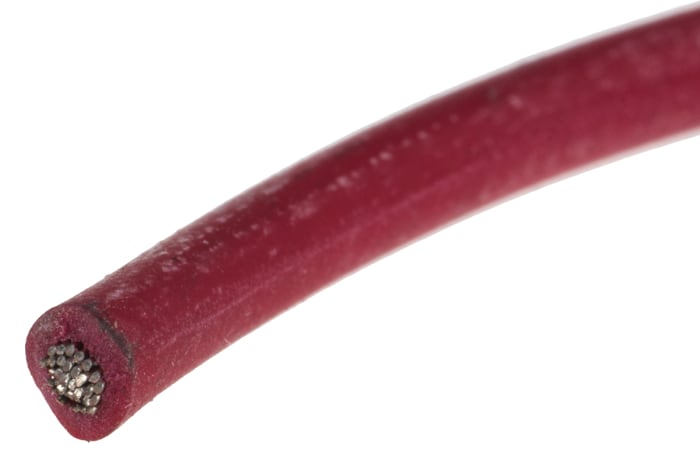RS PRO Black 1mm² Hook Up Wire, 32/0.2 mm, 100m, Silicone Rubber Insulation

Technical Document
Specifications
Brand
RS ProCross Sectional Area
1mm²
Sheath Colour
Black
Cable Shape
Single Core
Core Strands
32/0.2 mm
Length
100m
Insulation material
Silicone Rubber
Voltage Rating
500 V
Outer Diameter
2.5mm
Maximum Operating Temperature
+180°C
Minimum Operating Temperature
-60°C
Conductor Material
Tinned Copper
Cable Type
Harsh Environment
Wire Style
BS6195
Insulation Wall Thickness
0.8mm
Size of Strands
0.2mm
Resistant To
Corona Discharge, Heat, Oils, Ozone, Radiation, Solvents, Weathering
Number of Strands
32
Country of Origin
Italy
Product details
RS PRO Harsh Environment Wire - Silicone Rubber
Brought to you by RS PRO, Tinned copper conductors covered with 0.8 mm wall thickness silicone rubber to BS 6195 table 4. These cables will satisfy a wide number of applications related to medical, electronic or electrical equipment which may be operated in environmental conditions. Perfect in situations where ozone, corona discharge, radiation, heat, weathering or the normally adverse effects of a wide range of oils, solvents, etc, may be encountered. All models are highly reliable and excellent quality.
Features and Benefits
• Tinned Copper
• Silicone rubber insulation
• Various wire sizes
• 0.8 mm wall thickness
What is harsh environment wire?
Defined by its name, harsh environment wire is cable suitable for less than friendly environments. Typically used as hook up wire, each reel performs to an optimum level within harsher areas. High temperature can be a massive threat in terms of electronics, causing all kinds of health and safety risks. These RS PRO cables provide excellent resistance to such problems.
Where is harsh environment wire used?
Any electronic devices situated within harsh environments would benefit from this type of wire. Laboratories would be be a good example, as they are areas which could have toxic and potentially damaging gasses that interfere with wires. As as example, some areas using these cables would be:
• Construction sites
• Car engines
• Aeroplanes
• Petrol stations
SR 656.69
SR 656.69 1 Reel of 100 Metres (ex VAT)
SR 755.19
SR 755.19 1 Reel of 100 Metres (inc. VAT)
1
SR 656.69
SR 656.69 1 Reel of 100 Metres (ex VAT)
SR 755.19
SR 755.19 1 Reel of 100 Metres (inc. VAT)
1
Stock information temporarily unavailable.
Please check again later.
Technical Document
Specifications
Brand
RS ProCross Sectional Area
1mm²
Sheath Colour
Black
Cable Shape
Single Core
Core Strands
32/0.2 mm
Length
100m
Insulation material
Silicone Rubber
Voltage Rating
500 V
Outer Diameter
2.5mm
Maximum Operating Temperature
+180°C
Minimum Operating Temperature
-60°C
Conductor Material
Tinned Copper
Cable Type
Harsh Environment
Wire Style
BS6195
Insulation Wall Thickness
0.8mm
Size of Strands
0.2mm
Resistant To
Corona Discharge, Heat, Oils, Ozone, Radiation, Solvents, Weathering
Number of Strands
32
Country of Origin
Italy
Product details
RS PRO Harsh Environment Wire - Silicone Rubber
Brought to you by RS PRO, Tinned copper conductors covered with 0.8 mm wall thickness silicone rubber to BS 6195 table 4. These cables will satisfy a wide number of applications related to medical, electronic or electrical equipment which may be operated in environmental conditions. Perfect in situations where ozone, corona discharge, radiation, heat, weathering or the normally adverse effects of a wide range of oils, solvents, etc, may be encountered. All models are highly reliable and excellent quality.
Features and Benefits
• Tinned Copper
• Silicone rubber insulation
• Various wire sizes
• 0.8 mm wall thickness
What is harsh environment wire?
Defined by its name, harsh environment wire is cable suitable for less than friendly environments. Typically used as hook up wire, each reel performs to an optimum level within harsher areas. High temperature can be a massive threat in terms of electronics, causing all kinds of health and safety risks. These RS PRO cables provide excellent resistance to such problems.
Where is harsh environment wire used?
Any electronic devices situated within harsh environments would benefit from this type of wire. Laboratories would be be a good example, as they are areas which could have toxic and potentially damaging gasses that interfere with wires. As as example, some areas using these cables would be:
• Construction sites
• Car engines
• Aeroplanes
• Petrol stations

